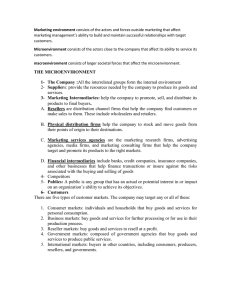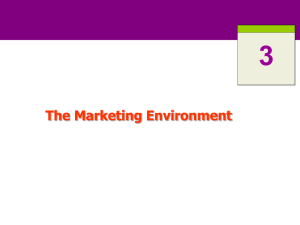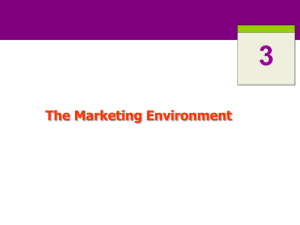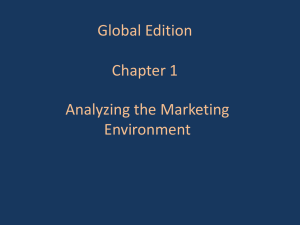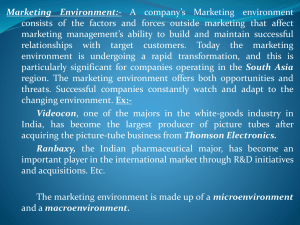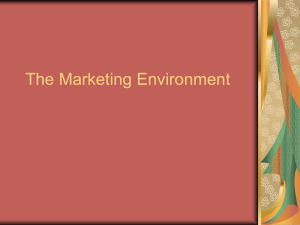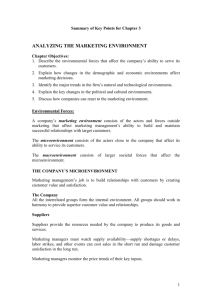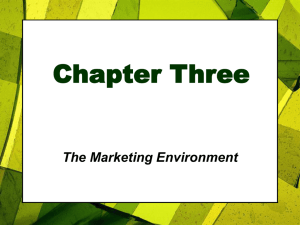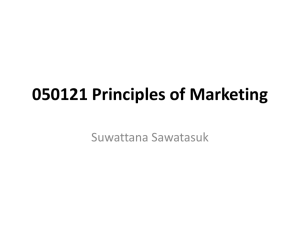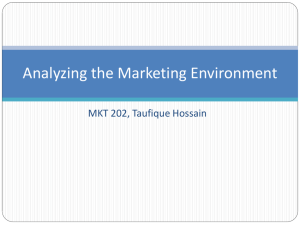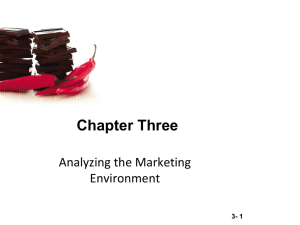Chapter-3-outline.doc
advertisement
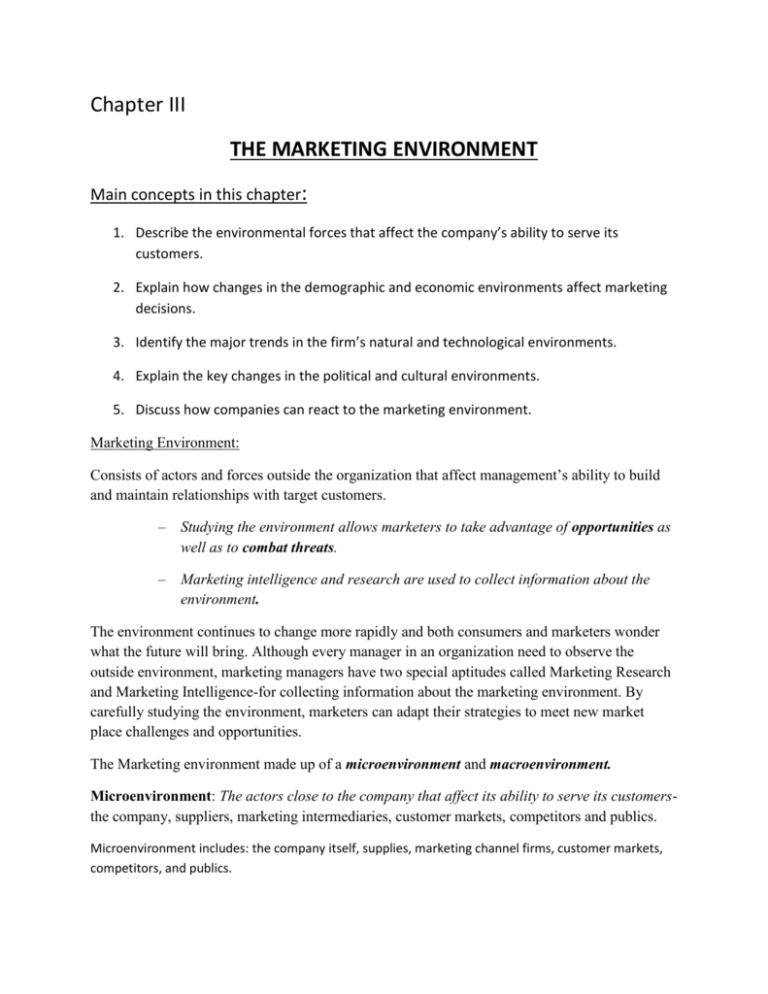
Chapter III THE MARKETING ENVIRONMENT Main concepts in this chapter: 1. Describe the environmental forces that affect the company’s ability to serve its customers. 2. Explain how changes in the demographic and economic environments affect marketing decisions. 3. Identify the major trends in the firm’s natural and technological environments. 4. Explain the key changes in the political and cultural environments. 5. Discuss how companies can react to the marketing environment. Marketing Environment: Consists of actors and forces outside the organization that affect management’s ability to build and maintain relationships with target customers. – Studying the environment allows marketers to take advantage of opportunities as well as to combat threats. – Marketing intelligence and research are used to collect information about the environment. The environment continues to change more rapidly and both consumers and marketers wonder what the future will bring. Although every manager in an organization need to observe the outside environment, marketing managers have two special aptitudes called Marketing Research and Marketing Intelligence-for collecting information about the marketing environment. By carefully studying the environment, marketers can adapt their strategies to meet new market place challenges and opportunities. The Marketing environment made up of a microenvironment and macroenvironment. Microenvironment: The actors close to the company that affect its ability to serve its customersthe company, suppliers, marketing intermediaries, customer markets, competitors and publics. Microenvironment includes: the company itself, supplies, marketing channel firms, customer markets, competitors, and publics. Macroenvironment: The larger societal forces that affect the microenvironment. These forces are considered to be beyond the control of the organization. Macroenvironment includes: demographic, economic, natural, technological, political, and cultural forces. THE COMPANY’S MICROENVIRONMENT: The actors in the microenvironment: 1. Company’s Internal Environment: a. Areas inside a company such as Top management, Finance, Research and Development (R&D), purchasing, operations, and accounting. b. Affects the marketing department’s planning strategies. Top management sets the company’s mission, objectives and other strategies. Marketing managers make decisions within the strategies and plans made by top management. c. All departments must “think consumer” and work together to provide superior customer value and satisfaction. Finance is concerned with funding and using funds to carry out the marketing plans. R&D focuses on how to design safe and attractive products. Purchasing department worry about getting supply and materials, whereas Operations department is responsible for producing and distributing desired quality and quantity of products. Accounting department has to measure the revenues and costs and inform the marketing department, how well it is achieving its objectives. 2. Suppliers Suppliers are an important link in the “value delivery system.” Suppliers provide resources needed to produce goods and services. Marketing managers must watch Supplier’s availability-supply shortages or delays, labor strikes that can damage customer satisfaction in the long run. Rising supply costs may force price increase that can harm company’s sales volume. Most marketers treat suppliers like partners in creating and delivering customer value. 3. Marketing Intermediaries Firms that help the company to promote, sell, and distribute its goods to final buyers. Marketing intermediaries include i. Resellers ii. Physical distribution firms iii. Marketing services agencies iv. Financial intermediaries Resellers are distribution channel firms that help the company to find its customers or make sales to them. These include wholesalers and retailers who buy and resell merchandise. Wal-Mart, Carrefour, Best Buy etc are examples of big retailers. Physical distribution firms help the company to stock and move goods from their points of origin to their destinations. Working with a warehouse and transportation firms, a company must determine the best ways to determine store and ship goods looking at the factors such as cost, delivery, speed and safety. Marketing services Agencies are the marketing research firms that help the company target and promote its products to the right market. Financial intermediaries include banks, credit companies, insurance companies and other businesses that help the finance transactions or insure against risks associated with the buying and selling goods. 4. Customers Five types of markets that purchase a company’s goods and services. i. Consumer Consumer market consists of individuals and households that buy goods and services for personal consumption. ii. Business Business markets buy goods and services for further processing or for use in their production process. iii. Reseller Reseller markets buy goods and services to resell at a profit. iv. Government Government markets are made up of government agencies that buy goods and services to produce public services or transfer the goods and services to others who need them. v. International International market consists of buyers in other countries including consumers, producers, resellers, and governments. 5. Competitors The marketing concept states that for a company to be successful, it must provide greater customer value and satisfaction than its competitors do. a. Those who serve a target market with products and services that are viewed by consumers as being reasonable substitutes. b. Company must gain strategic advantage against these organizations. No single competitive marketing strategy is best for all firms. Each firm should consider its own size industry position compared to its own competitors. 6. Publics A public is any group that has an interest in or impact on an organization's ability to achieve its objectives. We can identify seven types of publics. i. Financial public These influence the company’s ability to obtain funds. Banks, investment houses and stockholders are the major financial publics. ii. Media public These carry news, features etc. They include newspapers, magazines, and radio and television stations. iii. Government public Management must take government developments into account. Management must always follows the government rules and regulations when doing businesses mainly on issues of product safety, truth in advertising and other matters. iv. Citizen-action public A company’s marketing actions may be questioned by consumer organizations, environmental groups and others. Public Relations Department can help it stay in touch with consumer and citizen groups. v. Local public These include neighborhood resident and community organizations. vi. General public A company needs to be concerned about the general public’s attitudes towards its products and activities. The public image of the company affects its buying. vii. Internal public These include workers, managers, volunteers, and the board of directors. Large companies use newsletters and other means to inform and motivate their internal publics. When employees feel good about their company, this positive attitude spills over to the external publics. THE COMPANY’S MACROENVIRONMENT The company and all of the other actors operate in a larger macroenvironment of forces that shape opportunities and pose threats to the company. 1. DEMOGRAPHIC ENVIRONMENT The study of human populations in terms of size, density, location, age, gender, race, occupation, and other statistics. -Marketers track changing age and family structures, geographic population shifts, educational characteristics, and population diversity. Thailand Demographics: More than 85% speak a Thai language and share a common culture. This core population includes the central Thai (33.7% of the population, including Bangkok), Northeastern Thai or Lao (34.2%), northern Thai (18.8%), and southern Thai (13.3%). Population: 65,493,298 Age structure: 0-14 years: 21.2% (male 7,104,776/female 6,781,453) 15-64 years: 70.3% (male 22,763,274/female 23,304,793) 65 years and over: 8.5% (male 2,516,721/female 3,022,281) (2008 est.) Population growth rate: 0.64% (2008 est.) Sex ratio: Under 15 years: 15-64 years: 65 years and over: total population: 1.05 male(s)/female 0.98 male(s)/female 0.83 male(s)/female 0.98 male(s)/female (2008 est.) Ethnic groups: Tai (including Lao, who make up about ⅓ of the Thai population): 75%, Chinese : 14%, Others: 11% Religions: Buddhism : Islam : Christianity : Hinduism: Other (including Judaism): 94.6%, 4.6%, 0.7%, 0.1%, 0.1% 2. ECONOMIC ENIVRONMENT: Market requires buying power as well as people. The economic environment consists of factors that affect consumer purchasing power and spending patterns. Thai Economy: The economy of Thailand is lower middle income industrial developing nation, heavily export-dependent, with exports accounting for 60% of GDP. The exchange rate has reached 37.00/usd (GDP $7.3 trln baht) as of October 26, 2006, for a nominal GDP at market rates of approximately US$ 200 bln. However, due to rapid appreciation in 2007, nominal GDP hovers around $230 bln, slightly smaller than that of Guangdong. This keeps Thailand as the 2nd largest economy in Southeast Asia, after Indonesia, a position it has held for many years. Despite this, Thailand ranks midway in the wealth spread in SouthEast Asia as its 4th richest nation per capita, after Singapore, Brunei, and Malaysia. It is also an anchor economy for the neighboring least developed countries of Laos, Burma, and Cambodia. Thailand's recovery from the 1997-98 Asian financial crisis relied on exports, largely on external demand. Thailand has a strong automotive export industry along with electronic goods manufacturing which has helped to strengthen the baht. Agriculture has always been traditional income generation, but has declined in relative terms in recent years as overall exports increased. Tourism has been on the rise as well, but not without negative consequences. With the instability surrounding the recent coup, however, the GDP growth of Thailand has settled at around 4% from previous highs of 57% under the previous administration, as locals as well as foreign companies hold investment back due to political uncertainty. 3. NATURAL ENVIRONMENT: Natural environment involves natural resources that are needed as inputs by marketers or that are affected by marketing activities. Factors include: a. Shortages of raw materials. Air and water may seem to be infinite resources. Water shortages are already a problem in most of the industrial nations now. Renewable resources such as Forests and food have to be used wisely. Non renewable resources such as Oil, coal, various minerals pose a serious problem. b. Increased pollution. A second environmental trend is increased pollution. Industry will almost always damage the quality of the natural environment. Disposal of Chemicals and nuclear wastes, the dangerous mercury levels in the ocean, the quantity of chemical pollutants in the soil and food supply, littering the environment with non bio degradable wastes such as plastics, bottles and other packaged materials are very big examples of Increased pollution. c. Increased government intervention. The governments of different countries vary in their concern and efforts to promote a clean environment. Some rich countries like Germany are very strict on environmental quality where some poor nations do little about pollution, largely because they lack the needed funds or political will. 4. TECHNOLOGICAL ENVIRONMENT The Technological Environment is perhaps the most dramatic force now shaping our destiny. It includes forces that create new technologies, creating new product and market opportunities. The technological environment: • Changes rapidly. All of today’s common products were that were not available 100 years ago or even 30 years ago. Abraham Lincoln did not know about automobiles, airplanes, radios or the electric light. John F Kennedy did not know about personal computers, cell phones, DVD players or the internet. • Creates new markets and opportunities. New technology creates new markets and opportunities. However every new technology replaces an older technology. Marketers should watch the technological environment closely. Companies that do not keep up will soon find their products outdated. And they will miss new product and market opportunities. Total US R&D spending reached about $312 billion in 2005. • Challenge is to make practical, affordable products. Many companies are adding marketing people to R&D teams to try to obtain a stronger marketing orientation. Scientists are speculating on fantasy products such as flying cars, 3 D televisions, and living in space colonies. The challenge in each case is not only technical but also commercial- to make practical, affordable, versions of these products. • As products and technology become more complex, the public needs to know that they are safe. The government agencies investigate and ban potentially unsafe products. Safety regulations result in higher research costs and longer time between conceptualization and introduction of product. 5. POLITICAL ENVIRONMENT Political environment includes laws, government agencies, and pressure groups that influence or limit various organizations and individuals in a given society. Areas of concern: a. Increasing legislation. b. Changing government agency enforcement. c. Increased emphasis on ethics and socially responsible behavior. 6. CULTURAL ENVIRONMENT The cultural environment is made up of institutions and other forces that affect a society’s basic values, perceptions, preference, and behaviors. People grow up in a particular society that shapes their basic beliefs and values. a. Core beliefs and values are passed on from parents to children and are reinforced by schools, churches, business, and government. b. Secondary beliefs and values are more open to change. i. Marketers may be able to change secondary beliefs, but NOT core beliefs. Society’s major cultural views are expressed in people’s views of: c. Themselves d. Others e. Organizations f. Society g. Nature h. The universe
